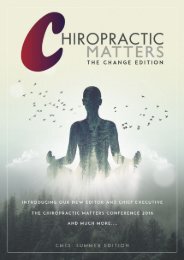aaCM 13 in design
You also want an ePaper? Increase the reach of your titles
YUMPU automatically turns print PDFs into web optimized ePapers that Google loves.
RESEARCH<br />
From the McTimoney College of Chiropractic<br />
All of these abstracts have been previously represented<br />
at both national and <strong>in</strong>ternational research conferences.<br />
Neurophysiological response to sp<strong>in</strong>al adjustment:<br />
An <strong>in</strong>vestigation us<strong>in</strong>g changes <strong>in</strong> electrodermal activity.<br />
John-Paul Taylor MChiro, Adrian Hunnisett PhD MPhil, Christ<strong>in</strong>a Cunliffe DC PhD<br />
Introduction<br />
Chiropractic theories postulate a relationship between the sp<strong>in</strong>e and the<br />
nervous system. An important manifestation be<strong>in</strong>g pathophysiology of the<br />
subluxation and the effects of sp<strong>in</strong>al adjustment on the body’s organ systems. If<br />
such theories are correct, there should be an aetiological connection between<br />
sp<strong>in</strong>al dysfunction and visceral dysfunction as well as a therapeutic<br />
connection [1].<br />
Changes <strong>in</strong> Autonomic Nervous System (ANS) activity can result from a<br />
variety of factors <strong>in</strong>clud<strong>in</strong>g physical movement, sleep<strong>in</strong>g, disease and age<strong>in</strong>g [2].<br />
In terms of sp<strong>in</strong>al adjustments the value of exam<strong>in</strong><strong>in</strong>g the ANS is to determ<strong>in</strong>e<br />
a neurophysiologic basis for the therapeutic benefits chiropractic patients<br />
report follow<strong>in</strong>g chiropractic healthcare.<br />
This study is a basic science <strong>in</strong>vestigation <strong>in</strong>to the neurophysiologic<br />
response of a specified chiropractic sp<strong>in</strong>al adjustment, build<strong>in</strong>g on scientifically<br />
acknowledged sp<strong>in</strong>al adjustment/manipulation research and utilis<strong>in</strong>g EDA as an<br />
accepted objective measure of neurophysiologic effect.<br />
Method<br />
Follow<strong>in</strong>g ethical approval from the university IRB, a prospective, double-bl<strong>in</strong>d,<br />
placebo-controlled, randomized trial was <strong>design</strong>ed to determ<strong>in</strong>e the percentage<br />
difference <strong>in</strong> sk<strong>in</strong> conductance measures, obta<strong>in</strong>ed before and after a<br />
specific chiropractic sp<strong>in</strong>al adjustment relative to sham and control conditions.<br />
A total of 45 eligilble healthy, asymptomatic, volunteers from the<br />
student, ex-student and staff populations of a chiropractic college were recruited<br />
to make up the total sample population. All<br />
volunteers gave <strong>in</strong>formed consent prior to participat<strong>in</strong>g <strong>in</strong> the research study.<br />
Participants were randomly allocated to one of three groups:<br />
1) Treatment: pre-<strong>in</strong>tervention protocol, <strong>in</strong>tervention protocol, and post-<strong>in</strong>tervention<br />
protocol. Treatment <strong>in</strong>volved specific high velocity low amplitude<br />
(HVLA) adjustment to the relative anterior transverse process of C1, on the<br />
Subject’s asymptomatic side.<br />
2) Placebo: pre-<strong>in</strong>tervention protocol, mimic the <strong>in</strong>tervention protocol, and<br />
post-<strong>in</strong>tervention protocol. In this case manual contact applied <strong>in</strong> the same<br />
manner as the treatment group to perform adjustment set-up (pisiform preload<br />
to transverse process), but with no adjustment of the vertebra.<br />
3) Control: Pre-<strong>in</strong>tervention protocol and post-<strong>in</strong>tervention protocol while<br />
<strong>in</strong>vestigator neither undertakes or mimics the <strong>in</strong>tervention on subjects.<br />
Introduction<br />
In the United K<strong>in</strong>gdom chiropractors are required to be evidence-based<br />
practitioners[1]. Evidence based practice (EBP) is the <strong>in</strong>tegration of best available<br />
evidence with cl<strong>in</strong>ical expertise and patient values <strong>in</strong> order to select the<br />
most appropriate management and deliver the best outcome for that patient.<br />
This necessitates that healthcare practitioners are able to access relevant<br />
research, understand how to appraise the quality of evidence that it provides<br />
and <strong>in</strong>tegrate this with their cl<strong>in</strong>ical expertise and apply it <strong>in</strong> practice[2]. One<br />
of the major barriers to the advancement of EBP <strong>in</strong> chiropractic is the lack of<br />
relevant cl<strong>in</strong>ical research and the funds to undertake high quality research[3].<br />
No studies have been carried out <strong>in</strong> the UK to evaluate the will<strong>in</strong>gness of<br />
chiropractors to provide funds for research, nor of their attitudes toward the<br />
necessity to generate research, perceived priority areas of research or op<strong>in</strong>ions<br />
regard<strong>in</strong>g adm<strong>in</strong>istration of any funds. That is the aim of this study.<br />
Pre-<strong>in</strong>tervention protocol consisted of an <strong>in</strong>itial 2 m<strong>in</strong>ute ‘stabilisation’ period<br />
followed by a 3 m<strong>in</strong>ute ‘basel<strong>in</strong>e-data’ period, giv<strong>in</strong>g a total of 5 m<strong>in</strong>utes SC<br />
data. Intervention protocol represented the ‘<strong>in</strong>tervention’ period when one of<br />
the three conditions was undertaken. The post-<strong>in</strong>tervention protocol <strong>in</strong>cluded<br />
a 3 m<strong>in</strong>ute ‘f<strong>in</strong>al-data’ period immediately after the <strong>in</strong>tervention and a further 2<br />
m<strong>in</strong>ute ‘rest‘ period, another total of 5 m<strong>in</strong>utes SC data.<br />
Data was analysed us<strong>in</strong>g InStat v3 (www.GraphPad.com) follow<strong>in</strong>g data preparation<br />
with Microsoft Excel.<br />
Results<br />
The chiropractic adjustment to C1 produced a sympathoexcitatory response<br />
compared with control group (p



